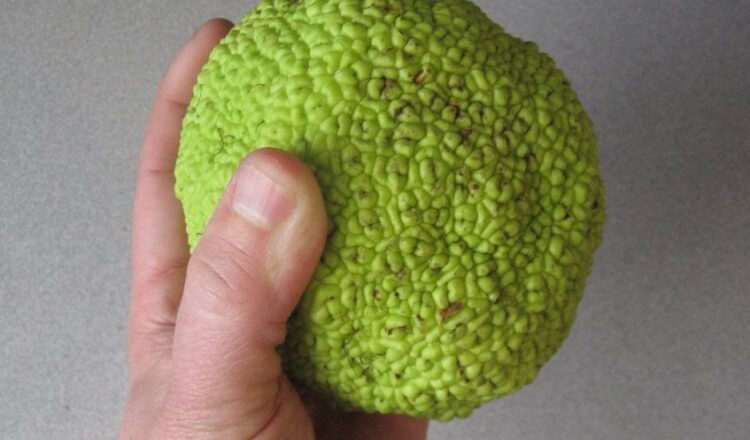By Bob Confer
In the fall you might see some strange fruits falling from trees throughout Western New York. These mammoth, warty balls that are the size of softballs are called Osage oranges.
Unlike true oranges, you can’t eat these fruits. Rock hard, they take some time to turn soft and rot; therefore, they tend to be quite bothersome to any homeowners who might have one of the trees in their yard.
These trees, though, did have some uses — and some alleged uses – that make for an interesting history.
Legitimate uses of the Osage orange
Long ago, before the advent of barbed wire, ranchers throughout the country used Osage orange trees as hedgerows and natural fence lines. The trees grow rather quickly and straight (reaching heights of 50 feet)…and they can be as nasty as barbed wire: The trees sport squat, powerful thorns on the limbs. Cattle would not leave their designated ranches because they could not bust through the hedges without great pain and serious bloodletting.
Its widespread planting outside of its natural range of the southern US was facilitated by the tree’s ability to handle almost anything thrown at it – drought, oppressive cold, insects and disease. It was a tree that a farmer could plant and forget about. The properties of the wood (it’s strong, heavy and shrink-proof) also lent the trees to being cut down and turned into fence posts and furniture.
Prior to the clearing of the land and the white man setting foot on North American soil, Native Americans found much use for Osage orange trees. They made war clubs out of the wood and they fashioned some of their best performing bows from it. Some hardcore archers still to this day revel in its brilliance in that regard. As a matter of fact, one name for this tree is bois d’arc which is French for “bow wood.” Native Americans also extracted yellow dyes from the wood that were used as face paints and to color clothing.
Where to find them
Despite their use throughout the farmlands of America, Osage oranges weren’t commonly used in the region, so they remain a relatively uncommon find in Western New York. In the days of old, local farmers here preferred to make hedgerows of locusts, alders and oaks as this land was more for fruits and grains than it was for roaming cattle in large numbers. But, they’re still here. To find these remnants of old ag practices, look along hedgerows, roads, and old rail lines, where the fallen fruit the tell-tale indicator of their presence.
Do Osage oranges deter spiders?
If you frequent farmers markets or fall festivals, you might see Osage oranges for sale. This commercial activity is based on the long held belief that Osage oranges repel spiders. Allegedly, if you place the fruits around your foundation in the fall, spiders won’t enter your home. Some people even go so far as to put the fruits under their bed to keep creepy crawlies like spiders and bed bugs away from their sleeping quarters.
Neither of those practices work. The magical powers of the oranges are mostly mythical.
I say “mostly” because an Iowa State University study found that there are chemical compounds in Osage oranges that are offensive to cockroaches – but they appear in such minute quantities in the fruits that they have absolutely no effect on roaches, spiders, or any arthropod for that matter. To repel any crawling critters the chemical would have to be served up in super-concentrated amounts that can be prepared only in a laboratory.
Scientists believe that Osage oranges only appear to work because the fruits fall to the earth at the same cool times that spiders and insects are winding down their activity for the year.
So, do yourself a favor. Don’t put the fruits around your house. They don’t work.
And certainly don’t put them under your bed. There, the smelly fruits would probably serve as a repellent – not for spiders, but instead for anyone who you might want to join you there.







